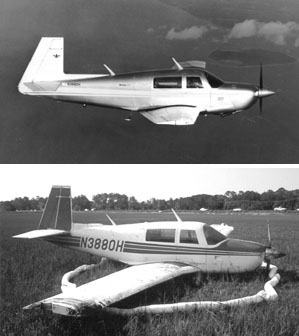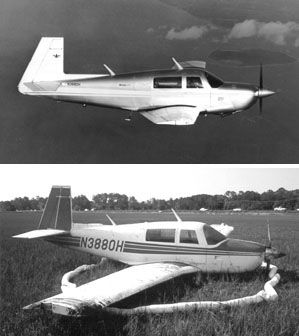
You cant have been around airplanes for long before hearing the tired old clich about those who have and those who will. As an all-purpose predictor of the inevitable, apply it to anything you like, from landing wheels up to the serious bending of metal.
Does that mean that everyone gets a chance at the latter? If so, our turn on the wheel came in mid-April, when the engine of our heretofore trusted Mooney quit on takeoff. Within moments, the airplane transitioned from an avionics showpiece to a mud-spattered scrap heap resting ignominiously in a South Carolina tidal flat.
And so ends the service history-we adamantly refuse to cave into emotionalism and call it a life-of N3880H, a 1980 J-model Mooney weve owned off and on for the better part of two decades.
Utilitarian to the end, we’ll try to squeeze some editorial value out of this calamity by telling you what we think we did right and what we did wrong and what we would do differently next time while all the while hoping there never is a next time.
Summarizing up front, we offer these lessons: You never have as much insurance as you think you have or as much as you in fact need; when airplane engines quit, the world may be utterly blas about the reason and, last, shopping for a replacement will reveal that you never have as much insurance as you think you have.
Way Back
Aviation Consumer first purchased N3880H in 1982, when the airplane was only two years out of the Kerrville factory. Why a Mooney as the company steed? For the same reasons other pilots opt for Mooneys: relatively cheap to buy, moderately fast and with reasonable operating costs. The airplane served we’ll as a multi-purpose combination test bed and corporate hack.
In 1990, we sold the airplane and bought into another Mooney partnership based at nearby Bridgeport. After that partnership dissolved amicably and we were again looking for another airplane, a friend e-mailed about a 1980 201 for sale by an owner in Delaware. The airplane was the very same N3880H, now sporting 400 more hours and a couple of new boxes in the panel. After a clean pre-buy, we bought the airplane back, sight unseen.
Shortly thereafter, our own chickens came home to roost. Just before we sold it, the airplane had been landed gear up and repaired with an overhaul whose price, shall we say, did not envision long-term pro-ration.
A hundred hours into our second ownership, a piston ring failure lead to a cracked case and the engine was junk. That development led directly to the purchase of a Lycoming factory overhaul in June of 1996, the engine that ended its days in a South Carolina swamp.
The Call
Its the ominous phone call that begins with you know about the airplane, right? or did so-and-so-call…? The only response is helpless resignation. My wife phoned with the barest details: One of our partners was enroute to Florida and after a fuel stop, the engine quit on takeoff at Beaufort, South Carolina, coming to rest in a weedy tidal swamp. No one was hurt.
With that out of the way, next comes the flood of questions. What happened and why? How much damage? Can we save the thing? The engine simply stopped making power, with a right jink and a run for the swamp off the end of the runway as the only option.
The impact was violent enough to have significantly damaged the wing tips and a rollout-more like a sloppy, short slide-through the soft mud bent the gear doors and the prop, as the airplane sunk to the wing in thick, salty muck.
Since the airplane was fueled immediately before the incident-even though the aircraft was declared a total loss, this wasnt classified as an accident-we were told the airport fuel truck was impounded and, presumably, later checked for contamination.
We say presumably because neither we nor the insurer-USAIG-was formally informed of the results. The airport manager didnt return our phone calls inquiring about this, nor did the FAAs cursory report mention it.
And then the airplane sat, mired in the tidal mud, from Sunday afternoon when the incident occurred until the following Wednesday evening, when equipment was brought in to recover it to the dry land of the airport.
Post Mortem
In most such incidents or accidents, both the FAA and NTSB are notified but when no injuries or deaths are involved, the NTSB leaves it up to the FAA to complete the investigation. In our case, the FAA sent not a field inspector but a designated airworthiness representative, Jim Stoia. He also operates Precision Air in nearby Manning, South Carolina, a shop that specializes in aircraft recovery and heavy airframe repair.
The recovery crew deposited the airplane on the airport ramp, rinsed it off and dug out the caked mud from inside the engine cowling. Although the prop had been bent, Stoia determined that it hadnt been bent enough to preclude running the engine, if it would start. It did.
Stoia told us he found clean, clear gasoline in the gascolater and injector lines and although the boost/priming pump had been trashed by saltwalter incursion, the engine fired on the third blade without priming and ran normally to full power. There was no evidence of fouled plugs or ignition failure and certainly this wasnt a case of fuel exhaustion. Then what?
Vapor lock? Maybe, although its all but unheard of in stopping Lycomings. How about water in the gas? If so, it worked through the lines and puked out before the airplane impacted. Intermittent magneto? Doubtful. The mag was freshly overhauled but mags either work or they don’t; phantom failures are rare. In the end, this one was logged in the unknown cause column.
USAIG Steps In
From the day of the incident forward, the recovery and insurance claim was handled by Mark Thompson of USAIGs Atlanta office. By remote control he orchestrated the recovery and was present to inspect the airplane when Stoia ran the engine, four days after the incident.
The verdict was swift and unpleasant. Thompsons inspection revealed that although the airplane had suffered only moderate sheet metal damage, during its three days in the swamp, salt water had evidently risen to the mid-seat level in the cabin, presenting a corrosion risk that he felt was irreparable. From USAIGs point of the view, the airplane was a total loss. We were told to expect a settlement check within a few weeks.
Well admit to a degree of angst over this assessment. As noted in the sidebar, the airplane had been thoroughly fogged with anti-corrosion compound at its annual inspection three weeks before and if ever there was a time for it to survive a dunking, this was it. On the other hand, as our agent and Aviation Consumer contributor Jon Doolittle observed, better to be disappointed with a $112,000 check in hand than to be devastated five years hence with a repaired airplane showing signs of uneconomic corrosion.
In the end, although we were sorry to see the airplane scrapped, we have to agree with USAIGs assessment. Even though we toyed with the idea of buying the hull back and repairing it, Thompson declined the offer and, in the end, he may have saved us from a disaster. Estimated repair costs were about $60,000 on a hull worth between $100,000 and $120,000.
USAIG did allow us to buy back the principle avionics, which included a Garmin GNS 430 and an UPSAT/Apollo MX-20. There’s a certain heartburn in buying back what you already own until you realize that upon declaration of a total loss, the insurance company owns everything down to the barf bags.
Overall, we thought USAIG did a terrific job handling the claim, as contributor Doolittle told us they have a reputation for doing.
Weve insured with USAIG for many years and from time to time, weve paid a higher premium for our loyalty, something that paid off when our claim was processed.
If we have any suggestions on how USAIG could improve its claim service, we would have liked more frequent phone updates during the recovery; we had to initiate most of the phone communication ourselves to learn where we stood. Further, we have the nagging feeling that if the recovery had commenced sooner, the airplane would have been salvageable.
We Luck Out
Most owners who suffer a hull loss receive an immediate and harsh lesson in the reality of aircraft ownership: when something bad happens, you are almost always underinsured. And so were we, but not by much.
Heeding Doolittles advice, we had carefully pondered the aircrafts rising value at each insurance renewal during the fall. Complicating the value equation was the amount of money we had invested in state-of-the-art avionics as part of our ongoing testing of this equipment.
Were hard pressed to see the sense of investing more than 10 percent of aircraft value in upgraded avionics but these days, given the cost of even modest upgrades, 20 or 30 percent is not unusual.
We had paid $71,500 for the airplane in 1995, added an engine ($18,200) and avionics upgrades totaling $27,000 for a total investment of $116,700. As weve noted many times, an owner can expect to recover only a portion of the investment cost of avionics and other upgrades.
But even though that investment cant be recovered at sale, its replacement can be fully insured. At the time of loss, 80Hs Bluebook value, given the high-time engine, chipped and dull paint and worn interior was probably around $93,000. The airframe was much higher time than average but its value was propped up by the avionics. In our favor was the post 9/11 softness in aircraft sales and Mooneys bankruptcy, both of which had combined to depress Mooney values, making for a strong buyers market and flat sales activity.
Following a hull loss, owners are immediately confronted with the challenge of finding a replacement aircraft and for long-term owners such as us, finding the equivalent of what you had is a prayer. Youre almost certain to pay more for less.
We had the airplane insured for $112,000, having bumped up the coverage the previous fall. While we don’t expect to find an equivalent airframe for that total-at least not one with the avionics we had assembled-the fact that Mooney values are depressed and we were able to buy back our boxes takes some of the sting off the loss.
The lesson learned from this calamity is chiefly economic. When an insurance renewal comes due, review your hull value carefully, consider what youve invested in avionics. Add it all up and pick an insured value closer to actual replacement value than to Bluebook value. True, you’ll pay a higher premium but when you shop for a replacement airplane, the extra cash will at least make you feel closer to being whole again.
Last, the emotional hit. To be perfectly harsh about it, we view airplanes as hapless collections of metal, wire, rubber and fluids stitched together to form the perfect bottomless money sink. We would never stoop to calling an airplane a her or-gasp!-give one a name.
Yet…the sight of our empty hangar evokes a certain melancholy twinge. We know all about opportunity emerging from setbacks and silver-lined dark clouds. All the same, we would just as soon have N3880H back, thanks.
Also With This Article
Click here to view “Couldnt We Save It?”
-by Paul Bertorelli





